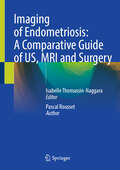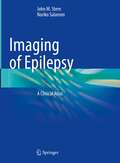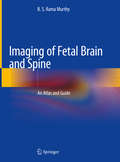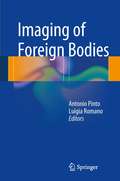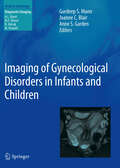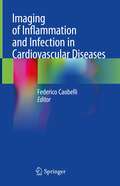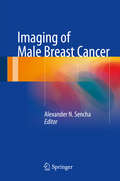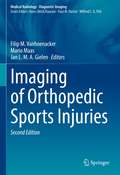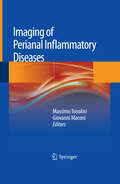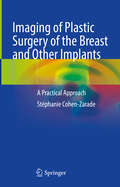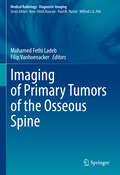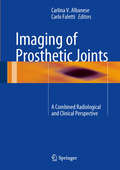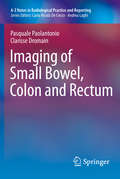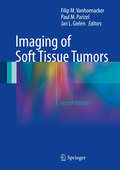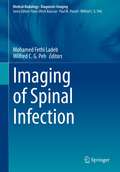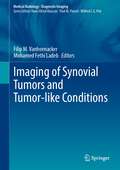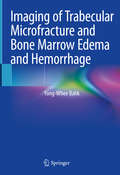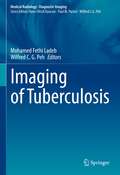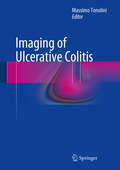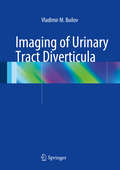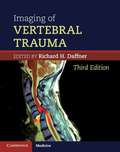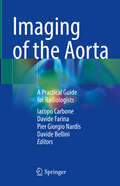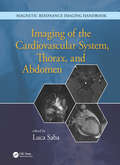- Table View
- List View
Imaging of Complications and Toxicity following Tumor Therapy
by Hans-Ulrich Kauczor Tobias BäuerleDepending on their mechanism of action, the cytotoxic and targeted drugs and radiotherapy employed in oncologic treatment may cause complications and toxicities in many organ systems, with variable radiologic presentations. This comprehensive and excellently illustrated book covers the basics of therapy-induced complications and toxicities in oncologic patients, identifies their consequences for all the major organs, and describes the imaging of these impacts by means of the various radiologic modalities. By familiarizing radiologists with the most frequent and prominent toxicities that are recognizable on radiologic imaging following tumor therapy, it will facilitate identification of their early manifestations and permit differential diagnosis based on relevant findings.
Imaging of Endometriosis: A Comparative Guide of US, MRI and Surgery
by Pascal RoussetThis book presents integrated learning to diagnose endometriosis, combining all imaging modalities such as transvaginal ultrasonography, MRI, and laparoscopy. The different forms of endometriosis are detailed with a systematic compartmental analysis focusing on radiosurgical correlation and the impact of imaging for predicting surgical findings. The chapters on superficial and adnexal endometriosis include typical and atypical findings. Deep pelvic endometriosis is detailed, with descriptions of central deep pelvic locations splitted into dedicated chapters for: anterior (bladder and round ligament), middle (torus, uterosacral ligament posterior vaginal pouch, adenomyosis), and posterior (rectosigmoid). Lateral localisations are described, as well as parietal fascia (including nervous localisation) and pelvic and extrapelvic locations, including diaphragmatic, thoracic, and abdominal wall location. Finally, this book explains how to perform the different imaging techniques and how to report ultrasonography, MRI, and laparoscopic surgery when exploring endometriosis. The descriptions provided in the book are based on international consensus (IDEA, dPEI, #Enzian score, …). The text is richly supported by radiological and surgical images.
Imaging of Epilepsy: A Clinical Atlas
by John M. Stern Noriko SalamonThis clinically-oriented collection of brain imaging results provides a unique and helpful approach to the epilepsy evaluation.The atlas is divided into sections according to general clinical categories with each category including a collection of clinical examples that span the category. Each example includes images across the relevant imaging modalities that relate to one patient, whose history accompanies the images. This case-based organization with clinical history and multiple images offers a complete visual understanding of the imaging findings and the corresponding relationship of each finding to the clinical presentation, treatment, and outcome.Images for the book are from the UCLA Seizure Disorder Center, which is a referral center that serves a large outpatient epilepsy patient population and performs approximately 500 inpatient epilepsy evaluations annually.Comprehensive and richly illustrated, this book will serve as a convenient resource in neurologic and radiologic practice, and useful for board exam review.
Imaging of Fetal Brain and Spine: An Atlas and Guide
by B. S. Rama MurthyThis book systematically covers the anatomy and pathology of the fetal brain and spine. It features a veritable treasure trove of ultrasound images illustrating every common finding, as well as rare lesions that are encountered in clinical practice. Wherever possible, it also includes 3D ultrasound and fetal MRI correlations.
Imaging of Foreign Bodies
by Antonio Pinto Luigia RomanoMost ingested foreign bodies pass through the gastrointestinal tract without a problem. However, both ingested and inserted foreign bodies may cause bowel obstruction or perforation or lead to severe hemorrhage, abscess formation, or septicemia. Foreign body aspiration is common in children, especially those under 3 years of age, and in these cases chest radiography and CT are the main imaging modalities. This textbook provides a thorough overview of the critical role of diagnostic imaging in the assessment of patients with suspected foreign body ingestion, aspiration, or insertion. A wide range of scenarios are covered, from the common problem of foreign body ingestion or aspiration in children and mentally handicapped adults through to drug smuggling by body packing and gunshot wounds. Guidance is offered on diagnostic protocols, and the value of different imaging modalities in different situations is explained. Helpful management tips are also provided. This textbook will prove invaluable for residents in radiology, radiologists, and physicians who are involved on a daily basis, within an emergency department, in the management of patients with suspected ingestion, aspiration, or insertion of foreign bodies.
Imaging of Gynecological Disorders in Infants and Children
by Gurdeep S. Mann Anne S. Garden Joanne C. BlairThis textbook provides a comprehensive review of gynecological imaging in infancy, childhood, and adolescence. Experts from the disciplines of pediatric radiology, gynecology, surgery, and endocrinology have come together to produce a textbook that, while written primarily from the perspective of the radiologist, will be of value to all professionals involved in the management of these patients. The normal development of the female reproductive tract is described in detail through embryological development, normal childhood appearances, and puberty. Congenital abnormalities are addressed in chapters reviewing structural abnormalities of the reproductive tract and disorders of sex development. A symptoms-based approach is followed in chapters devoted to the assessment of the patient with gynecological pain and disorders of menstruation. Disorders of the breast and the imaging of patients with gynecological neoplasia are considered in dedicated chapters.
Imaging of Inflammation and Infection in Cardiovascular Diseases
by Federico CaobelliThis book addresses the most relevant imaging techniques in order to detect inflammation and infection in the most common cardiovascular diseases. The book presents data concerning molecular imaging (SPECT and PET) and cardiac magnetic resonance imaging (MRI) for each disease, with a special focus on the emerging role of hybrid PET/MR imaging. Different non-ischemic and ischemic diseases as well as cardiac infections are addressed in detail; these include: Cardiac sarcoidosis, Cardiac amyloidosis, the vulnerable plaque, Post-infarction inflammatory alterations, Pericarditis, Myocarditis, Cardiac devices infections, and Endocarditis. The book also provides a comprehensive discussion on new targets and new tracers, to date mostly investigated at a pre-clinical stage, thus constituting an excellent basis for translational imaging. Imaging of Inflammation and Infection in Cardiovascular Diseases will be of interest not only for experts in clinical imaging, but also pre-clinical scientists and will be invaluable for both nuclear medicine physicians and radiologists.
Imaging of Male Breast Cancer
by Alexander N. SenchaThis book is devoted to the diagnosis and treatment of male breast pathology. It provides a comprehensive overview of current strategies for the diagnosis of breast malignancies in men, with a focus on imaging modalities. Ultrasound of male breast abnormalities is discussed in particular depth, but the roles of other imaging techniques, genetic tests, and interventional diagnostic modalities are also carefully covered. Special attention is paid to differential diagnosis of malignant and benign lesions, and the most important benign breast diseases are described and illustrated with high-quality images. A special chapter analyzes treatment strategy in men with breast malignancies and principles of follow-up after breast surgery. Individual chapters are also devoted to the diagnosis of recurrent cancer and cancer metastases. This up-to-date and richly illustrated book will interest and assist specialists in ultrasound diagnostics, radiologists, oncologists, and surgeons.
Imaging of Orthopedic Sports Injuries (Medical Radiology)
by Filip M. Vanhoenacker Mario Maas Jan L. M. A. GielenThis volume provides an updated review of imaging abnormalities in orthopedic sports injuries. The first part of the book contains background information on relevant basic science and general imaging principles in sports traumatology. The second part comprises a topographic discussion of sports injuries. Each chapter highlights the merits of different imaging techniques, focused on a specific clinical problem. In the third part, natural history, monitoring and follow-up imaging are discussed.
Imaging of Perianal Inflammatory Diseases
by Massimo Tonolini Giovanni MaconiThis practical volume is intended for all radiologists, gastroenterologists, and surgeons who are responsible for, or interested in, the diagnosis and care of patients with diseases of the anal and perianal region. After an introductory section focusing on surgical, MRI, and US anatomy, up-to-date clinical and therapeutic information is provided on the full range of perianal inflammatory conditions, with special attention to Crohn's disease, ulcerative colitis, and sexually transmitted diseases. Physical and surgical examination is carefully discussed, with consideration of limitations, results, clinical needs, and the questions likely to be posed of imaging. The subsequent three sections provide detailed information on the different imaging modalities: transanal and transperineal ultrasound, contrast-enhanced MRI, and CT. Techniques, diagnostic accuracy, common and unusual disease patterns, artifacts, and pitfalls are clearly presented.
Imaging of Plastic Surgery of the Breast and Other Implants: A Practical Approach
by Stéphanie Cohen-ZaradeIn this comprehensive book, the author describes in a didactic and concise manner the sometimes misunderstood post-surgical aesthetic radiological aspects that can be misleading.It is intended for radiologists, whether or not specialized in breast imaging, cosmetic surgeons, gynecologists, and other specialists who are interested in aesthetics, in full development.In this book, all techniques of breast augmentation-reduction, butt augmentation, calf augmentation, pectus excavatum correction, are thoroughly described: surgical procedures, post-surgical radiological aspects or complications.For each technique, the imaging protocol to be performed is detailed.A rich and specific collection of radiological pictures facilitates understanding.This is an essential book that can be used for training purposes.
Imaging of Primary Tumors of the Osseous Spine (Medical Radiology)
by Mohamed Fethi Ladeb Filip VanhoenackerThis comprehensive book provides a detailed description of imaging techniques and findings in the detection, characterization, local staging and post-treatment tumors of the osseous spine. In the first part of the book, the epidemiology, classification, pathology, genetics and molecular biology are discussed. The second part gives an overview of the basic semiology, imaging modalities including CT, MRI, PET and PET-CT, and staging. The third part of the book discusses the imaging of primary bone tumors of the spine and its mimics. In the fourth part, the treatment of tumors and tumor-like conditions of the spine is reviewed. The final part of the book summarizes post-treatment evaluation and assessment. Thus, the book will be a useful reference for general and musculoskeletal radiologists and residents, orthopaedic surgeons, oncologists and histopathologists.
Imaging of Prosthetic Joints
by Carlina V. Albanese Carlo FalettiAn increasing percentage of the population has at least one prosthetic joint. Imaging is required for both initial assessment and routine follow-up of the implant, and this book is intended as an informative and up-to-date guide to the subject. After an introductory section covering a range of background topics, the level of information offered by different imaging techniques in presurgical planning and postimplantation assessment is analyzed. The application of imaging to different joints is then carefully explored in chapters devoted to the foot and ankle, hip, knee, shoulder, and elbow, wrist and hand. In addition, two innovative chapters focus on periprosthetic DXA as the gold standard in monitoring implant survival and on the role of drug therapy in helping to ensure the durability of the prosthesis. A central feature of the book is its combination of the clinical and radiological perspectives; it will be of value to radiologists and orthopedic specialists, as well as residents in these disciplines.
Imaging of Small Bowel, Colon and Rectum
by Pasquale Paolantonio Clarisse DromainThe new series A-Z Notes in Radiological Practice and Reporting provides practical guides for residents and general radiologists, organized alphabetically, primarily according to disease or condition. All booklets are designed so as to cover a large spectrum of topics referring to different anatomical regions of interest. Entries typically include a short description of pathological and clinical characteristics, guidance on selection of the most appropriate imaging technique, a schematic review of potential diagnostic clues, and useful tips and tricks. The present booklet, enriched by illustrations and schemes, is devoted to gastrointestinal imaging. Major topics in CT and MR imaging of the small bowel, colon, rectum, and anus are treated concisely in alphabetical order. For each topic a brief review of clinical features and pathology is presented, followed by a short description of imaging technique and an accurate review of imaging findings and signs which are useful in the differential diagnosis of gastrointestinal disease.
Imaging of Soft Tissue Tumors
by Filip M. Vanhoenacker Paul M. Parizel Jan L. GielenThis richly illustrated book, in an extensively revised new edition, provides a comprehensive survey of the role of medical imaging studies in the detection, staging, grading, tissue characterization, and post-treatment follow-up of soft tissue tumors. The indications for and relative merits of various imaging modalities are fully described, with particular emphasis on the role of advanced MRI techniques that can improve diagnostic accuracy and evaluation of treatment response. The most recent version of the WHO Classification of Soft Tissue Tumors is introduced, and individual chapters are devoted to imaging of each of the tumor groups in that classification as well as other soft tissue masses. Numerous new illustrations of both common and rare tumors are included, providing a rich pictorial database of soft tissue masses. In addition, imaging findings are correlated with clinical, epidemiologic, and histologic data. Imaging of Soft Tissue Tumors will be of value in daily practice not only for radiologists but also for orthopedic surgeons, oncologists, and pathologists.
Imaging of Spinal Infection (Medical Radiology)
by Wilfred C. G. Peh Mohamed Fethi LadebThis book examines all aspects of the imaging of spinal infection. The diagnosis of spinal infection has been a challenge for many years. In addition to clinical and laboratory findings and histopathological examination, imaging has a major role in aiding and expediting the correct diagnosis. This book comprehensively addresses how imaging can help in localizing the site and specifying the extent of a variety of spinal infections.After introductory chapters on the epidemiology and pathophysiology of spinal infection, the different imaging techniques are discussed in detail. The bulk of the book addresses different specific spinal infections caused by various pathogens. These comprise chapters on hematogeneous pyogenic spondylodiscitis, iatrogenic spinal infection, pyogenic epidural abscess, spinal brucellosis, salmonella spondylodiscitis, spinal tuberculosis, spinal hydatidosis, and fungal spondylodiscitis. The last chapter describes diagnostic algorithm of spinal infection.The book is written by Tunisian, Asian and European experts and will be a valuable resource for all medical practitioners who deal with spinal infection, including radiologists, rheumatologists and orthopedic surgeons.
Imaging of Synovial Tumors and Tumor-like Conditions (Medical Radiology)
by Filip M. Vanhoenacker Mohamed Fethi LadebThis vastly illustrated book offers a comprehensive survey of the role of imaging in the diagnosis of synovial tumors and tumor-like conditions. It gives an overview of the anatomy and histology of the synovium and discusses the classification, pathology, genetics and molecular biology of synovial tumors. The book presents the benefits of various imaging modalities in the diagnosis of these masses, which is important to provide appropriate treatment.Imaging of Synovial Tumors and Tumor-like Conditions will be a valuable resource not only for radiologists but also for orthopedic surgeons, oncologists, radiotherapists, and pathologists.
Imaging of Trabecular Microfracture and Bone Marrow Edema and Hemorrhage
by Yong-Whee BahkThis excellently illustrated monograph summarizes the updated fresh information on the theoretical, practical, and rapidly extended facets of gamma correction 99mTc-hydroxymethylene diphosphonate pinhole bone scan (99mTc-GCPBS) to MRI, CR, and MDCT. Basically, 99mTc-GCPBS is able to precisely visualize and quantitate callused trabecular microfracture (CTMF) which is as little as 200 μm in size. The extended gamma correction images can very neatly demonstrate CTMF on MRI, conventional radiography (CR), and multidetector computed tomography (MDCT). Whenever appropriate, histological correlation is provided in conjunction with fine gamma corrected images. In this setting, ACDSee 10 gamma correction MRI and CR have been found to offer a highly useful option that deserves wider clinical interest. In practice, gamma correction MRI, CR, and MDCT can distinctly visualize CTMF so that CTMF can be precisely measured simply using an optic lens. By comparison, the naïve MRI, for example, shows CTMF which measures as big as 2 mm in size. Furthermore, 99mTc-GCPBS can now differentiate bone marrow edema from hemorrhage using the visuospatial mathematic method, which includes the ImageJ of the NIH.
Imaging of Tuberculosis (Medical Radiology)
by Wilfred C. G. Peh Mohamed Fethi LadebThis book provides an extensive overview of the role of imaging in the detection, diagnosis, management, and follow-up of tuberculosis. Chapters cover the disease's epidemiology and pathophysiology, microbiological diagnosis and pathology relevant to radiologists, and the distinct aspects of imaging tuberculosis at various locations and body systems. This book discusses recent advances in imaging pertaining to tuberculosis, and addresses the approach to patients with tuberculosis and HIV co-infection. The final chapter offers an algorithmic approach to the diagnosis and management steps of tuberculosis. Imaging of Tuberculosis is an updated and comprehensive reference source that covers imaging of tuberculosis in a structured fashion and is valuable for radiologists.
Imaging of Ulcerative Colitis
by Massimo TonoliniDuring the past decade, the medical and surgical treatment of ulcerative colitis has undergone dramatic advances, including the widespread use of immunomodulators, biological drugs, and restorative proctocolectomy. In order to correctly balance the risks and benefits of medical therapies and surgical procedures, there is a need for improved diagnosis of colonic disease, acute complications, extraintestinal manifestations, and early and delayed postoperative complications. Cross-sectional imaging techniques are therefore playing an increasing role in the assessment of ulcerative colitis and provide an essential complement to clinical data and endoscopy. This practical, illustrated volume on the role of cross-sectional imaging is aimed at radiologists, gastroenterologists, and surgeons who are engaged or interested in the diagnosis and care of patients with inflammatory bowel disease, particularly ulcerative colitis. After an overview of diagnostic imaging techniques, state-of-the-art assessment of colorectal inflammatory disease with CT colonography using water enema is discussed, followed by description of the plain radiographic and CT findings in patients with acute exacerbations and surgical complications. Subsequent chapters review the diagnostic findings and role of cross-sectional imaging in the assessment of sclerosing cholangitis (with emphasis on MR cholangiopancreatography), vascular complications (particularly portal and mesenteric thrombosis), associated neoplasms, such as colorectal cancer and abdominal desmoids, and perianal inflammatory disease. Normal postoperative appearances and early and delayed complications in patients treated with proctocolectomy and ileal pouch-anal anastomosis are also comprehensively reviewed.
Imaging of Urinary Tract Diverticula
by Vladimir M. BuilovThis monograph covers all aspects of the radiologic diagnosis of urinary tract diverticula, including calyceal, ureteral, bladder and urethral diverticula. Characteristic and subtle diagnostic features are identified with the aid of numerous high-quality ultrasound, X-ray and magnetic resonance images, the vast majority of which are drawn from the author's personal clinical practice. In addition, issues relating to terminology, classification, statistics, etiology, pathogenesis, clinical presentation and differential diagnosis are discussed. The text is complemented by two helpful appendices that document the latest recommendations of the European Society of Urogenital Radiology regarding use of contrast media and the European Medicines Agency on minimizing the risk of nephrogenic systemic fibrosis when using gadolinium-containing contrast agents. This book will be of value for specialists in radiology and urology and also trainees and medical students.
Imaging of Vertebral Trauma
by Richard H. DaffnerThe imaging methods used to evaluate patients with suspected vertebral injuries have undergone radical changes in the past decade, the most significant being the ascendancy of computed tomography (CT) to become the primary investigative modality. Issues such as high radiation dose associated with CT studies and health care reform and cost containment also have a significant impact on clinical decision-making. This new edition of the classic landmark text for vertebral trauma imaging provides an in-depth discussion on the indications and methods of imaging the spine based on currently available clinical evidence. Every chapter has been extensively revised and the illustrations represent state-of-the-art imaging. A completely new chapter on pediatric injuries has been added. Imaging of Vertebral Trauma, third edition, is an invaluable and essential tool in the assessment of any patient with suspected vertebral or spinal cord injury.
Imaging of Vertebral Trauma (3rd Edition)
by Richard H. DaffnerThe imaging methods used to evaluate patients with suspected vertebral injuries have undergone radical changes in the past decade, the most significant being the ascendancy of computed tomography (CT) to become the primary investigative modality. Issues such as high radiation dose associated with CT studies and health care reform and cost containment also have a significant impact on clinical decision-making. This new edition of the classic landmark text for vertebral trauma imaging provides an in-depth discussion on the indications and methods of imaging the spine based on currently available clinical evidence. Every chapter has been extensively revised and the illustrations represent state-of-the-art imaging. A completely new chapter on pediatric injuries has been added. Imaging of Vertebral Trauma, third edition, is an invaluable and essential tool in the assessment of any patient with suspected vertebral or spinal cord injury.
Imaging of the Aorta: A Practical Guide for Radiologists
by Iacopo Carbone Davide Farina Pier Giorgio Nardis Davide BelliniThis book provides younger radiologists with a practical guide to aortic imaging, from acquisition to reporting. It discusses the pros and cons of the different available techniques and offers tips for the optimization of acquisition protocols and it covers the most frequent aortic pathologies, from a diagnostic and interventional point of view. Report building is discussed starting from standardized terminology; for each pathology, the book lists, in a simple and schematic way, the key points that must be included in the report of a cross-sectional study. Checklists used by clinicians and radiologists in routine practice are also included, and iconography is enriched by numerous stand-alone images. The Authors have long-standing experience in cardiovascular imaging and interventional procedures and with this publication they are providing a useful guide in everyday clinical practice.
Imaging of the Cardiovascular System, Thorax, and Abdomen
by Luca SabaMagnetic resonance imaging (MRI) is a technique used in biomedical imaging and radiology to visualize internal structures of the body. Because MRI provides excellent contrast between different soft tissues, the technique is especially useful for diagnostic imaging of the brain, muscles, and heart. <P><P>In the past 20 years, MRI technology has improved significantly with the introduction of systems up to 7 Tesla (7 T) and with the development of numerous post-processing algorithms such as diffusion tensor imaging (DTI), functional MRI (fMRI), and spectroscopic imaging. From these developments, the diagnostic potentialities of MRI have improved impressively with an exceptional spatial resolution and the possibility of analyzing the morphology and function of several kinds of pathology. <P><P>Given these exciting developments, the Magnetic Resonance Imaging Handbook: Imaging of the Cardiovascular System, Thorax, and Abdomen is a timely addition to the growing body of literature in the field. Offering comprehensive coverage of cutting-edge imaging modalities, this book: <Li>Discusses MRI of the heart, blood vessels, lungs, breasts, diaphragm, liver, gallbladder, spleen, pancreas, adrenal glands, and gastrointestinal tract <Li>Explains how MRI can be used in vascular, posttraumatic, postsurgical, and computer-aided diagnostic (CAD) applications <Li>Highlights each organ’s anatomy and pathological processes with high-quality images <Li>Examines the protocols and potentialities of advanced MRI scanners such as 7 T systems <Li>Includes extensive references at the end of each chapter to enhance further study <P><P>Thus, the Magnetic Resonance Imaging Handbook: Imaging of the Cardiovascular System, Thorax, and Abdomen provides radiologists and imaging specialists with a valuable, state-of-the-art reference on MRI.

